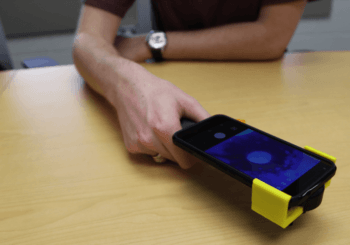Low-Cost Otoscope Works With Smart Phones

According to the World Health Organization 360 million people in the world suffer from hearing loss. A large portion of those affected live in developing countries, particularly South Asia, Asia Pacific and sub-Saharan Africa. Experts say at least half of all hearing loss cases are avoidable through primary prevention. In developing countries, however, primary prevention is hard to come by.
That is why a group of students at Texas A&M University has designed a low-cost otoscope that when plugged into a smartphone, can take photos of the inside of the ear. The group, members of Texas A&M’s chapter of Engineering World Health, has designed and built a model LED otoscope that it is submitting to the national organization’s design competition. The group’s hope is that its design could be turned into a kit for easy production around the world.
Robert Hunt, design team leader, and Tessa Bronez, vice president, both received degrees in biomedical engineering this May, and they hope the group continues to refine their design now that they have graduated.
“We have a lot of electrical engineers on the team, and they were really excited about doing something with optics,” Bronez said.
When Hunt and Bronez joined Engineering World Health three years ago, the group was small and there wasn’t a lot of interest, they said.
“We thought coming into our senior year, we should try to take some initiative and get more people involved and come up with something exciting,” Hunt said.
Engineering World Health provides a list of problems medical professionals are faced with, particularly in the developing world. That’s how Hunt and Bronez found out a low-cost LED otoscope was needed to help diagnose and treat those with hearing loss.
“We thought we could use a phone to make it low cost, because they could use the camera on the phone,” Bronez said. “A lot of people are surprised to hear that many people in developing countries have smartphones, particularly in the more urban areas where the hospitals are.”
Continue reading on Engineering Today.
This article by Kim Foli originally appeared in Engineering Today.





